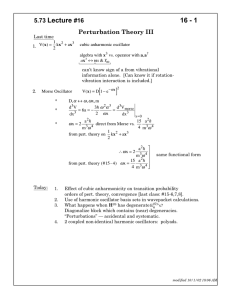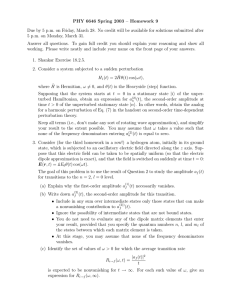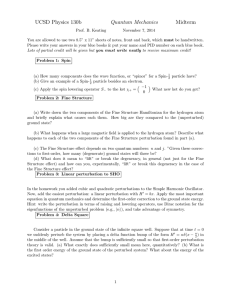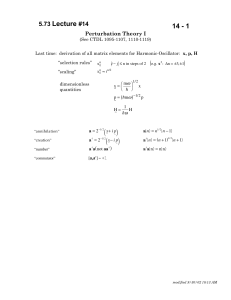17 - 1 Lecture 5.73 #17
advertisement
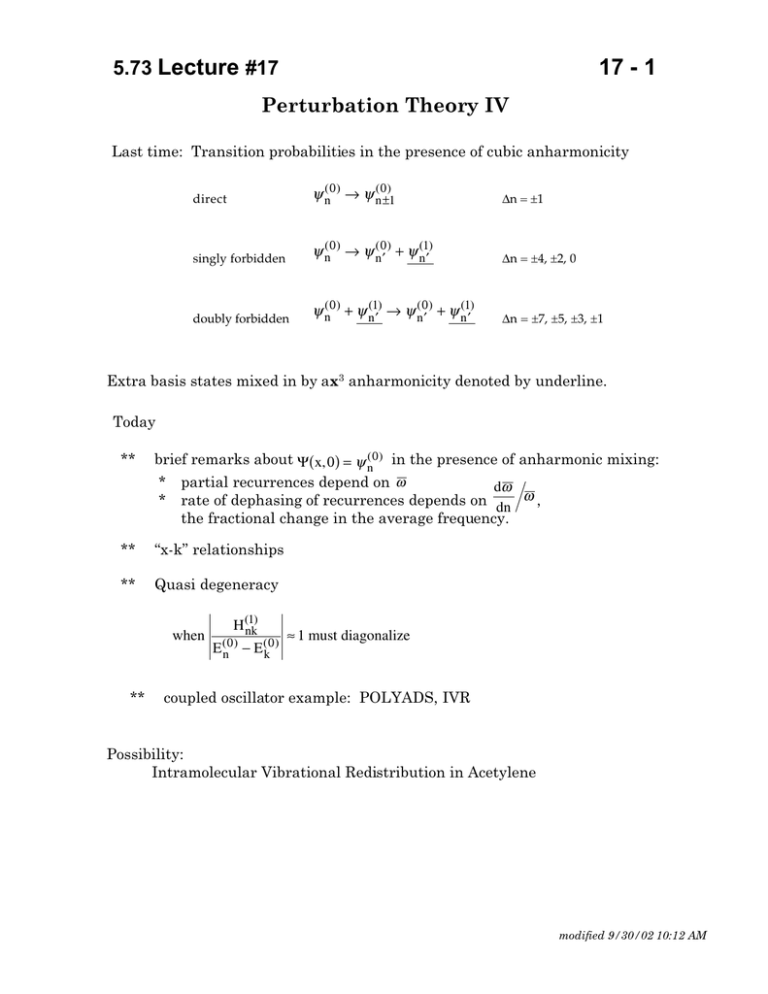
5.73 Lecture #17 17 - 1 Perturbation Theory IV Last time: Transition probabilities in the presence of cubic anharmonicity direct (0) ψ n(0) → ψ n±1 ∆n = ±1 singly forbidden (1) ψ n(0) → ψ n(0) ′ + ψ n′ ∆n = ±4, ±2, 0 doubly forbidden (1) ψ n(0) + ψ n(1)′ → ψ n(0) ′ + ψ n′ ∆n = ±7, ±5, ±3, ±1 Extra basis states mixed in by ax3 anharmonicity denoted by underline. Today ** brief remarks about Ψ( x, 0) = ψ n(0) in the presence of anharmonic mixing: * partial recurrences depend on ω dω * rate of dephasing of recurrences depends on dn ω , the fractional change in the average frequency. ** “x-k” relationships ** Quasi degeneracy when ** H(1) nk (0) E (0) n − Ek ≈ 1 must diagonalize coupled oscillator example: POLYADS, IVR Possibility: Intramolecular Vibrational Redistribution in Acetylene modified 9/30/02 10:12 AM 5.73 Lecture #17 17 - 2 What about Quartic perturbing term bx4? special hint 4 Note that E(1) n = n bx n ≠ 0 and is directly sensitive to sign of b! What about wave packet calculations? ψ n expressed as superposition of ψ k(0) basis state terms (perturbed eigenstates) Ψ( x,0) expanded as superposition of ψ k(0) terms (state prepared at t = 0) Ψ( x, t ) oscillates at e −iE n t h (evolving prepared state) (1) (2) E n = E (0) n + En + En A state which is initially in a pure ψ n(0) will dephase, then exhibit partial recurrences at m2 π where m is an integer ω but recurrence is not perfect since E n − Em ≠ hω ( n − m) m2 π ≈ ω n t not quite integer multiples E n + E n+1 2 decreases as n increases because * * ∴ t recurrence = time of 1st recurrence will depend on ⟨E⟩! successive recurrences will occur with larger phase error for ωn,n–1 vs. ωn+1,n 1st recurrence phase discrepancy is δ 2nd recurrence phase discrepancy is 2δ etc. modified 9/30/02 10:12 AM 5.73 Lecture #17 17 - 3 On pages 16-5 through 16-11 I worked out how a block of Heff is corrected so that “out-of-block” off-diagonal matrix elements can be safely ignored. These corrections come in two forms: (i) Second-order perturbation theory corrections to diagonal matrix elements. One example is the “x–k” relationships by which the xij vibrational anharmonicity constants are evaluated in terms of third and fourth derivatives of V(Q). (ii) Van Vleck transformation of “quasi-degenerate” or “resonant” blocks of Heff. Something analogous to second-order perturbation theory is used to fold out-of-block off-diagonal matrix elements into polyad blocks along the diagonal of H. These corrections occur both on and off the diagonal within these quasi-degenerate polyad blocks. “Resonance” is not accidental. Once it appears it affects larger and larger groups of near-degenerate basis states. Consider the following 3 × 3 example of a Van Vleck transformed Heff: 2 0 5 H = 5 2 0.5 2 0.5 20 This H has a 2 ↔2 quasidegenerate block and both members of this block interact weakly with a nonquasidegenerate remote state. modified 9/30/02 10:12 AM 5.73 Lecture #17 17 - 4 0 0 0 H( 0 ) = 0 2 0 0 0 20 2 0 5 H(1) = 5 0 0.5 . 2 0 5 0 22 −20 1 H( 2 ) = − 19 0 (2)(0.5) 0+2 − 20 2 0.5 2 −18 0 0 2 2 0.5 2 + 20 18 0 (1) nk (1) kn ′ ( 0) n′ H H H = ∑ ( 0) En + E ( 0) in-block k − E k out-of-block 2 ( 2) nn ′ modified 9/30/02 10:12 AM 5.73 Lecture #17 17 - 5 See Ian M. Mills “Vibration-Rotation Structure in Asymmetric- and SymmetricTop Molecules”, pages 115-140 in Molecular Spectroscopy: Modern Research, Volume I, K. Narahari Rao, and C. Weldon Mathews, Academic, 1972. Second-order perturbation theory is used to derive the famous “x-k” relationships, namely the relationship between the second, third, and fourth derivatives of V(Q) and the normal mode ωi and xij molecular constants. G(V ) = ∑ ω (v i i + 1 /2) + i 1 V (Q) = 2 1 + 24 ∑ xij ( vi + 1 /2)( v j + 1 /2) i,j i ≥j ∂3V qr q s qt ∂qr∂q s∂qt ∑ ∂2V ∑ ∂ 4V qr q s qt qu ∂qr∂q s∂qt ∂qu r rstu 1 2 q + r 6 ∂qr2 ∑ rst [unrestricted sums: get several identical partial derivatives.] Lengthy derivations: 1 ∂V 1 x ii = ∑ 4 − 16 ∂q i 16 s 4 direct firstorder contribution from quartic force constant ∂ 3V 2 ∂q i ∂q s 2 (8ω 2i − 3ω 2s ) 2 2 ω s ( 4 ω i − ω s ) second-order summation over cubic force constants modified 9/30/02 10:12 AM 5.73 Lecture #17 1 ∂ 4V 1 xij = − 4 ∂qi2 ∂q 2j 4 17 - 6 ∑ t first-order from quartic force constant 1 2 ∑ t ∂ 3V ∂3V ∂q 2 ∂q 2 ∂ q i t j ∂qt ωt − second-order sum over ∆vi= ∆vj = 0 terms for cubic force constants 2 3 ∂V 2 2 2 ω ω ω ω − − t t i j ∂qi ∂q j ∂qt ( ) ∆ ijt second-order sum over all ∆vi = ±1, ∆vj = ±1 terms for cubic force constants ( )( )( )( ∆ ijt = ω i + ω j + ω t ω i − ω j − ω t −ω i + ω j − ω t −ω i − ω j + ω t ) ∆ijt is “Resonance denominator”. When ωi = ω j + ωt or ω j = ωi + ωt or ωt = ωi + ω j perturbation theory blows up. Must go to Heff polyads and diagonalize. modified 9/30/02 10:12 AM 5.73 Lecture #17 17 - 7 Degenerate and Near Degenerate E (0) n * * * Ordinary nondegenerate p.t. treats H as if it can be “diagonalized” by simple algebra. (0) CTDL, pages 1104-1107 → find linear combination of degenerate ψ n for which H(1) lifts degeneracy. This problem is usually treated in an abstract way by people who never actually use perturbation theory! Whenever H(1) nk must diagonalize the n,k 2 × 2 ≈1 (0) block of H = H(0) + H(1) E (0) − E n k accidental degeneracy — spectroscopic perturbations systematic degeneracy — 2-D isotropic H-O, “polyads” quasi-degeneracy — safe chunk of H effects of remote states — Van Vleck Pert. Theroy - next time Continuum Philosophy: En 0 particular class of experiments does not look at all En’s - only a given E range and only a given E resolution! Want a model that replaces ∞ dimension H by simpler finite one that does really well for the class of states sampled by particular experiment. NMR IR UV nuclear spins (hyperfine) vibr. and rotation electronic don't care about excited vib. or electronic don't care about Zeeman don't care about Zeeman modified 9/30/02 10:12 AM 5.73 Lecture #17 17 - 8 quasidegenerate block sampled by our specific experiment H= N×N quasidegenerate blocks sampled by other experiments each finite block along the diagonal is an Heffective fit model. We want these fit models to be as accurate and physically realistic as possible. fold important out-of-block effects into N × N block → 2 stripes of H diagonalize augmented N × N block - refine parameters that define the block against observed energy levels. next time review V-V = ψ n(0) ( x1 )ψ n(0) ( x 2 ) 1 2 * * ψ n(0)n 1 2 transformation 4. Best to illustrate with an example — 2 coupled harmonic oscillators: “Fermi Resonance” [approx. integer ratios between characteristic frequencies of subsystems] p2 1 p2 1 H = 1 + k1 x12 + 2 + k 2 x 22 + k122 x1 x 22 2m 2 2m 2 ψ why not k12x1x2? ψ (0) = ψ n(0) ( x1 )ψ n(0) ( x 2 ) n n (0) 1 2 n1 n 2 1 2 = ψ (n11) ( x1 )ψ (n02 ) ( x2 ) H1(0) E(0) n = hω1( n1 + 1 / 2 ) 1 E(0) n = hω 2 ( n 2 + 1 / 2 ) H(0) 2 E (0) nm = h[ω1( n + 1 / 2 ) + ω 2 ( n + 1 / 2 )] 2 let ω1 = 2ω 2 (m1 = m 2 , k1 = 4k 2 ) systematic degeneracies modified 9/30/02 10:12 AM 5.73 Lecture #17 17 - 9 h 3/2 1 H = = k122 2m ω ω 2 1 2 aa† + a†a = 2a†a + 1 (1) k122 x1 x 22 1/2 [(a + a )(a 1 † 1 2 2 † † + a†2 2 + aa + a a )] H(1) nm;kl H(1) = (constants) 6 types of terms n–k m–l a1a 22 –1 –2 [(n + 1)(m + 2)(m + 1)]1/2 a1a†2 2 –1 +2 [(n + 1)(m)(m − 1)]1/2 a1 2a†2 a 2 + 1 –1 0 [(n + 1)(2m + 1)]1/2 a1†a 22 +1 –2 [(n )(m + 2)(m + 1)]1/2 a1†a†2 2 +1 +2 [(n )(m)(m − 1)]1/2 +1 0 [(n )(2m + 1)]1/2 ( ( ) ) a1† 2a†2 a 2 + 1 H (1) Seems complicated – but all we need to do is look for systematic near degeneracies Recall ω1 = 2ω 2 E(0)/h ω 2 List of Polyads by Membership (n1 , n2) P = 2n1 + n2 degeneracy (0,0) 1 1+ 1/2 = 3/2 0 (0,1) 1 1 + 3/2 = 5/2 1 (1,0), (0,2) 2 3 + 1/2 = 7/2 2 (1,2), (0,3) 2 3 + 3/2 = 9/2; (2,0), (1,2), (0,4) 3 11/2 4 3 13/3 5 4 15/2 6 4 17/2 7 etc. 19/2 8 1 + 7/2 = 9/2 3 modified 9/30/02 10:12 AM 5.73 Lecture #17 17 - 10 General P block: 3 E (0) p hω 2 = 2 + ( 2n1 + n 2 ) = P + 3 / 2 # of terms in P block depends on whether P is even or odd P+2 states 2 P +1 states 2 n = P , n = 0 , n = P 2 − 1,2 ,…(0,2P ) 1 2 2 1 2 P − 1 n = , n 2 = 1 ,…(0,2P − 1) 1 2 even P odd P H(1) † † 2 † 2 † †2 † = a1a†2 3/2 −3/2 −1/2 −1 2 + a1 a 2 + a1a 2 + a1 a 2 + a1 2a 2 a 2 + 1 + a1 2a 2 a 2 + 1 −3/2 h m ω1 ω 2 k122 2 ∆P= 0 0 –4 +4 –2 +2 ( inside polyad ) ( between polyad blocks 0 0 0 P + 3 / 2 0 P+3/2 0 0 0 0 O 0 0 0 0 P + 3 / 2 H(0) P = hω 2 POLYAD n m P ,0 2 P − 1, 2 2 1/ 2 P P ,0 0 2 • 1) ( 2 2 P H(P1) 1 2 , − = 2 0 sym stuff M sym M 0 0 0, P 0 P − 2, 4 2 0 0 0 0 L 1/ 2 0 [(1)(2 P)(2 P − 1)] 0 1/ 2 P 2 − 1 (3 • 4) 0 sym 0 Note that all matrix elements may be written in terms of a general formula — computer decides membership in polyad and sets up matrix modified 9/30/02 10:12 AM ) 5.73 Lecture #17 17 - 11 So now we have listed ALL of the connections of P = 6 to all other blocks! So we use these results to add some correction terms to the P = 6 block according to the formula suggested by Van Vleck. H(2) P nm (1) H H(1) nk km = ∑ (0) (0) P′ En + Em − E(0) k 2 for our case*, the denominator is hω 2 [ P − P ′ ] * For this particular example there are no cases where there are nonzero elements for n ≠ m (many other problems exist where there are nonzero n ≠ m terms) 3 − 4 − 8 =−5 2 30 2 2 4 (2) 22 hω 2 H 6 3 −3 −1 −2 2 −3 = 14 h m ω1 ω 2 k122 2 06 dimensionless 50 75 4 36 − + − = −8 3 4 4 2 105 81 162 12 60 − + − =− 2 4 4 2 2 169 56 197 − − =− 2 4 2 Computers can easily set these things up. Could add additional perturbation terms such as diagonal anharmonicities that cause ω1 : ω2 2 : 1 resonance to detune. modified 9/30/02 10:12 AM 5.73 Lecture #17 17 - 12 For concreteness, look at P = 6 polyad (3,0), (2,2), (1,4), (0,6) H(1) 6 stuff 30 22 30 0 (3 ⋅ 2 ⋅1)1/2 22 sym 0 14 0 sym 06 0 0 14 0 (2 ⋅ 4 ⋅ 3)1/2 0 06 0 0 (1⋅ 5 ⋅ 6)1/2 sym 0 now what are all of the out of block elements that affect the P = 6 block? ∆P = –2 P=6~P=4 ( ) a1 2a†2 a 2 + 1 ( ) ∆P = +2 a1† 2a†2 a 2 + 1 ∆P = –4 a1a 22 H (1)/stuff (0) E(0) P − E P−2 3,0 ~ 2,0 31/2 +2h ω 2 2,2 ~ 1,2 1,4 ~ 0,4 0,6 ~ — 2 1/2 ⋅5 11/2 ⋅ 9 — +2h ω 2 +2h ω 2 — 3,0 ~ 4,0 2,2 ~ 3,2 1,4 ~ 2,4 41/2 31/2 ⋅ 5 21/2 ⋅ 9 –2h ω 2 –2h ω 2 –2h ω 2 0,6 ~ 1,6 3,0 ~ — 2,2 ~ 1,0 1,4 ~ 0,2 0,6 ~ — ∆P = +4 a1†a†2 2 3,0 ~ 4,2 2,2 ~ 3,4 1,4 ~ 2,6 0,6 ~ 1,8 11/2 ⋅ 13 — 21/2 (2 ⋅ 1)1/2 11/2 (4 ⋅ 3)1/2 –2h ω 2 — +4h ω 2 — +4h ω 2 — [4⋅2⋅1]1/2 –4h ω 2 [3⋅4⋅3]1/2 [2⋅6⋅5]1/2 [1⋅8⋅7]1/2 –4h ω 2 –4h ω 2 –4h ω 2 (0) (1) (2) H eff P=6 = H6 + H6 + H6 hω 2 ( 6 + 3 / 2 ) 0 0 0 0 0 0 0 0 0 0 0 0 0 0 0 0 0 0 0 0 0 0 modified 9/30/02 10:12 AM
